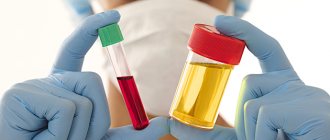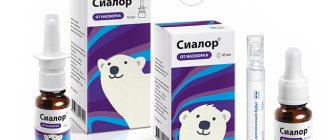Vomiting is a protective reaction of the body to toxins, bacteria or spoiled food entering the stomach. But it can appear with some functional disorders of the digestive tract, acute inflammatory processes, and pathologies of the central nervous system. Sometimes the vomit turns green. This does not always indicate a serious problem; perhaps the person has eaten too much greens, cucumbers, or other foods of that color.
Green vomiting in an adult: what to do and how to treat
Green vomiting in an adult may indicate chronic inflammatory processes, increased pressure inside the abdominal cavity and functional disorders in the organs of the digestive system.
Or about simple intoxication of the body due to food or alcohol poisoning. How to determine the specific cause and why you should see a doctor can be found below. Green vomit in an adult Vomit turns green due to increased bilirubin (bile pigment) in the blood or direct release of bile into the stomach.
Table 1. Possible causes of green vomit
ReasonDescription
| Liver diseases | In this case, vomiting has a yellowish tint and comes along with other symptoms - icteric complexion, bad breath, heartburn and nausea, general weakness, pain in the right side near the liver. |
| Biliary dyskinesia | This is a disease characterized by disruptions in the outflow of bile due to too frequent or, conversely, slow contraction of the gallbladder. The disorder is accompanied by specific symptoms - bitterness in the mouth, biliary colic, vomiting and nausea. |
| Diseases and inflammations of the digestive system, which led to the reflux of bile juice into the stomach | This may be due to sphincter pathology, absence of the gallbladder after cholecystectomy and poor diet, gastroenteritis (inflammation of the gastric mucosa), low stenosis of the duodenum, impaired innervation (when the connection between organs and the central nervous system worsens due to injury). Also, the reflux of bile into the stomach may be associated with exacerbation of pancreatitis, gastritis, acute appendicitis, or increased pressure inside the peritoneum due to constipation, irritable bowel syndrome and other diseases. A rare reason why masses turn green is the presence of congenital anomalies in the structure of organs in a person. |
| Acute intestinal infection | This may be typhoid and other types of typhus, salmonellosis, staphylococcus or cholera. |
| Functional disorders of the digestive system | For example, if there are not enough enzymes in the pancreas, then a large amount of bile is released into the stomach. As a result, the digested food changes its color. |
| Cerebral disorders | This applies to hypertensive crisis, encephalitis, head injuries, and brain tumors. |
| Intoxication | We are talking about an overdose of any medicine, alcohol, chemical or food poisoning of the body. |
| Functional impairment | It may occur due to endocrine diseases that cause insufficient production of hormones and enzymes in the body. |
| Tumor processes | Most often, intestinal cancer falls into this category, when the tumor puts pressure on the internal organs, which leads to the release of bile juice into the stomach. |
Important: due to the large number of reasons why green vomit may appear, it is not recommended to delay contacting a doctor. Only a specialist will be able to correctly diagnose the inflammatory process in the body and select medications.
The first symptom is a feeling of nausea. After vomiting, diarrhea may appear green in color and consistency with impurities of blood, bile or undigested food.
Then, depending on the reason why the green vomit appeared, the person’s condition and further symptoms vary. For example, if it is simple food poisoning, then after emptying the stomach it becomes easier for a while.
In case of infections and serious illnesses, repeated vomiting only makes you feel worse.
Urgent hospitalization and treatment will be required
Based on the nature of the vomit, one can assume the development of some pathological processes in the body:
- If it has a yellowish tint, it is a sign of a combination of hydrochloric acid and a large amount of bile in the stomach. All due to a violation of the outflow of bile (dyskinesia) and an increased acidic environment in the stomach.
- If it is heavily mixed with blood, this is a sign of bleeding in the ulcer, cirrhosis of the liver, oncology, varicose veins in the esophagus, hemorrhagic pancreatitis or erosive gastritis.
- If it is grayish in color and with a lot of mucus, this is a sign of chemical intoxication or mushroom poisoning.
- If it is dark green in color, then this indicates a mixture of copious amounts of bile and blood.
Black vomit indicates a drug overdose, red vomit indicates bleeding in the esophagus, yellow vomit indicates food poisoning. If the vomit is brown, then this is a clear sign of internal bleeding in the stomach. This happens with polyps, tumors and ulcers.
The green color of vomit can directly reflect food poisoning if the food was green (stale cucumbers, spinach, broccoli)
Vomiting greatly undermines the water-salt balance and leads to dehydration. To restore your well-being, it is recommended to drink warm water or other liquid. The main thing is not to rush and not to drink in large sips: this will lead to a repetition of the urge. Healthy sleep and diet play a big role in recovery. At first, you should avoid physical activity.
Drink more water
An important point: you should not self-medicate or take painkillers if you have green or yellow vomiting accompanied by acute abdominal pain. Such symptoms indicate appendicitis and other serious diseases that require emergency care. The same applies to cases where vomiting was provoked by a sharp jump in blood pressure.
It is also worth understanding that vomiting is only a concomitant symptom of various pathological conditions in the body, and not the main disease. Therefore, there are no uniform methods for treating vomiting; all cases are individual and require consultation with a doctor.
Antacids
For nausea, doctors prescribe drugs from the antacid category. They reduce stomach acidity and bring it back to normal. They especially help with green-yellow vomit with a bitter aftertaste.
How antacids work:
- creation of a film membrane in the mucosa;
- relieving irritation;
- relief of nausea;
- elimination of belching and heartburn.
Table 2. Classification of antacids
Classification
| By shape | |
| Pills | Suspensions |
| Dissolves quickly enough in the stomach. The main thing is to chew and dissolve the tablet before swallowing. Suitable for people leading an active lifestyle. In other cases, it is better to choose a suspension | They consist of smaller parts than tablets, and therefore dissolve faster and have a larger work area. Optimal for home treatment |
| According to the operating principle | |
| Suction | Non-absorbable |
| When interacting with gastric juice, they are absorbed by the walls of the organ and enter the blood. On the one hand, this gives an almost instant effect due to the rapid regulation of acidity in the stomach. On the other hand, they tend to release carbon dioxide. And this leads to belching, bloating, or even the re-release of bile into the stomach and recurrence of nausea. Therefore, for diseases of the digestive system and kidneys, it is better to choose non-absorbable antacids | More modern means than absorbable antacids. They give effect 6-12 minutes after consumption. Neutralize bile and pepsin, regulate acidity in the stomach without the release of carbon dioxide and the rebound phenomenon. By rebound we mean the return of symptoms and an increase in stomach acidity 1-2 hours after taking the tablet, which is typical for absorbed substances. Non-absorbable antacids combine several active ingredients. The only substance that can be absorbed by the stomach is a small amount of aluminum. Therefore, in case of renal failure, medications should be taken only with the permission of a doctor. |
| Examples: baking soda, Rennie, burnt magnesia | Examples: Magalfil, Rutotsid, Almagel, Gaviscon, Topalkan |
The most popular antacids: Gestid, Phosphalugel, Gestid, Gastal, Maalox, Taltsid. They come in both tablets and suspension form.
Maalox
Gastal
Sorbents
The most popular option is activated carbon. It will help with gastroenteritis or alcohol poisoning.
Activated carbon
Folk remedies
If there is no nausea, you are allowed to drink teas and medicinal herbal decoctions. The latter are especially relevant for diseases of the liver and gall bladder. Below are the most effective products and their properties.
Table 3. Effective folk remedies
MeansProperties
| Immortelle | Pain relief |
| Dandelion | Cleaning blood vessels and ducts |
| Yarrow | Improving intracellular metabolism, relieving pain in the right side and spasms, cleansing the body, dilating the ducts |
| Green tea leaves | Providing the body with minerals and vitamins, a positive effect on the endocrine and nervous systems, destruction of pathogens, pain relief |
| Ginger | Relieving gagging, preventing heartburn |
| Chicory | Increasing blood flow and metabolic processes, saturating cells with oxygen and restoring their structure, improving microcirculation |
| Burdock (burdock) | Restoration of cell structure, weakening of inflammatory processes and pain, removal of toxins, diuretic, laxative and choleretic effect |
| Milk thistle | Reducing the negative effects of toxic substances and poisons on liver cells |
Tincture recipes
Some tinctures will help alleviate the condition and strengthen the immune system. The main thing is to get a doctor’s permission before doing this, since contraindications are possible.
- infusion of dill seeds (1 teaspoon per glass). After brewing, leave for a few minutes, strain and drink 30 minutes before meals;
- cumin (teaspoon per glass). Leave for 5 minutes, add a teaspoon of powdered nutmeg and drink at once;
- horsetail and green walnut fruits. Mix and grind in a blender, pour one liter of boiling water. Drink up to 6 times a day, a third of a glass.
Infusion of dill seeds
For one-time yellow vomiting, no treatment is required. It is enough to get by with plenty of fluids and diet for two to three days. If you have green vomit, you will also have to go on a diet, but its duration will be many times longer. The specific period varies depending on the doctor's recommendations and the reason that caused the vomiting. Diet tips:
- An easy-to-digest diet with a balanced content of beneficial microelements, fats, proteins and carbohydrates is recommended;
- no soda, alcohol, strong coffee and tea, salted, smoked, fried, fatty or spicy foods, tomato soups;
- Steamed, grilled or boiled dishes, soups with vegetable broth are allowed;
- at first, no fruits and vegetables high in fiber. For example, apples, cucumbers, cabbage. They can cause injury to the unhealed gastric mucosa.
Symptoms and types of vomiting
This condition is usually accompanied by nausea. It can be of varying degrees of severity. In case of food poisoning, the patient feels better after it. If the pathology is caused by infection or functional disorders, vomiting does not bring relief. Often there is a decrease in appetite, even an aversion to food.
And if there is a large amount of mucus, one may suspect poisoning with potent poisons or a bite from poisonous insects. Vomit may be homogeneous or streaked with mucus or blood, or pieces of undigested food. In addition, this condition may be accompanied by green diarrhea. Loose stools appear with food poisoning and many pathologies of the digestive system. In this case, signs of dehydration occur: dizziness, weakness, weight loss, a sharp drop in blood pressure, convulsions.
In the most severe cases, vomiting may cause a fever, severe abdominal pain, and general malaise. If the green color of the vomit is due to a large amount of bile, after the stomach is emptied, a burning sensation occurs in the larynx and mouth.
What do the different shades and colors of green vomit mean?
Based on the nature of the vomit, one can assume the development of some pathological processes in the body:
- If it has a yellowish tint, it is a sign of a combination of hydrochloric acid and a large amount of bile in the stomach. All due to a violation of the outflow of bile (dyskinesia) and an increased acidic environment in the stomach.
- If it is heavily mixed with blood, this is a sign of bleeding in the ulcer, cirrhosis of the liver, oncology, varicose veins in the esophagus, hemorrhagic pancreatitis or erosive gastritis.
- If it is grayish in color and with a lot of mucus, this is a sign of chemical intoxication or mushroom poisoning.
- If it is dark green in color, then this indicates a mixture of copious amounts of bile and blood.
Black vomit indicates a drug overdose, red vomit indicates bleeding in the esophagus, yellow vomit indicates food poisoning. If the vomit is brown, then this is a clear sign of internal bleeding in the stomach. This happens with polyps, tumors and ulcers.
What is the danger of green vomit?
In rare cases, the appearance of green vomit is the only sign of a pathological process. Most often, additional symptoms are observed, which require contacting a medical facility. Risk of vomiting bile:
- dehydration;
- necrosis of the bile ducts due to stenosis;
- general intoxication of the body;
- the effect of caustic bile on the gastric mucosa provokes the appearance of erosions and inflammatory processes;
- changes in the epithelium of the esophagus with the development of Barrett's syndrome, which is considered a precancerous condition.
Other possible complications depend on the reasons that caused the release of bile with the food bolus.
Additional symptoms
Additional symptoms depend on the cause of the pathological process.
Table 1. Additional diagnostic signs for green vomit.
| Diseases | Symptoms |
| Gallstones | Pain of a paroxysmal nature, flatulence, bitter taste in the mouth, belching of air, weakness, upset stool, fever |
| Alcohol intoxication | Headaches, loss of consciousness, delirium delirium, inability to navigate in space |
| Pancreatitis | Pain in the hypochondrium, bitter taste in the mouth, after emptying the stomach of the food bolus there is no relief, rarely - diarrhea |
| Biliary colic | Severe pain, the patient rushes about because he cannot find a position in which relief occurs |
| Pyloric stenosis | Depends on the stage of the disease. In the initial stages, vomiting occurs rarely, and there is a feeling of fullness in the stomach. As the disease progresses, attacks develop after each meal. There is dehydration and weight loss. |
| Pregnancy | Normally, there are no additional signs. If any other symptoms appear, hospitalization is indicated. |
| Infectious diseases | Nausea, vomiting, epigastric pain, fever, diarrhea. |
| Upon admission |
medicines
Treatment methods for the condition
The cause of the disease should be treated, not the symptoms. If the episode was a one-time event, and then relief came and the condition returned to normal, there is no need to worry. If vomiting with bile recurs, you should contact a medical facility.
Patient management tactics depend on the diagnosis:
- Stones in the gall bladder, pyloric stenosis - only surgery. In case of cholelithiasis, the affected organ is removed; if the lumen is narrowed, measures are taken to restore patency in this area.
- Gallbladder colic – in the initial stages of the disease, it is recommended to use antispasmodics to relieve the attack. If the patient's condition worsens, removal of the gallbladder is indicated.
- Pancreatitis - treatment is carried out only in a hospital. In the first few days, it is forbidden to eat. The digestive system needs to rest. Antibiotics, drugs to suppress the secretory function of the organ, and enzyme drugs are indicated. After stopping the inflammatory process, it is necessary to follow a gentle diet.
- Alcohol intoxication - treatment can be carried out at home. Gastric and intestinal lavage, drinking plenty of fluids, drip administration of glucose, drugs for rehydration, and forcing diuresis are indicated. If the patient's condition worsens, the patient is hospitalized.
- Pregnancy – hospitalization in a specialized hospital according to indications.
- Infectious diseases of the gastrointestinal tract - antibiotics, antibacterial drugs, and medications are indicated to normalize the intestinal microflora.
- During chemotherapy, medications are prescribed to inhibit the vomiting center in the brain.
- When using medications, study possible contraindications and side effects. Then consult a doctor to adjust your prescriptions.
Vomiting liquid after eating, why did you vomit liquid after eating?
Vomiting liquid after eating can occur both during meals and some time after eating. Vomiting while eating is considered early and can be caused by gastritis or ulcerative formations in the stomach, and the coarser and heavier the food, the stronger the indigestion will be.
It should be noted that with neurosis, the severity of food will not cause vomiting, but, on the contrary, stimulate digestion. If nausea and vomiting occur a certain time after eating, then they are considered late. In this case, the occurrence of gag reflexes intensifies if a person bends over or lies down on the bed. There are also frequent cases when late vomiting is accompanied by pain in the chest area.
The red color of the vomit is due to the discovery of gastric bleeding in the patient. Less commonly, blood inclusions, clots, and traces of blood discharge in the vomit are found as a result of severe stomach cramps that occur directly during the process of vomiting. Red color of vomit, what could be the reasons? Considering that red vomit indicates the presence of blood impurities in it, which means a violation of the integrity of the vessels or tissues of the stomach, it poses an increased danger to human health. When red vomit appears, the only correct solution is to immediately call an ambulance.
The most dangerous situation is in which the vomit blood has a bright scarlet color. This indicates a high probability of damage to large blood vessels. If you vomit red vomit, what does it mean? Vomiting containing bright red blood or streaks of it indicates fresh, rapid bleeding that has opened in some part of the digestive tract.
The blood in the vomit may also be dark red, brown, or black. Consistency ranges from liquid to mushy, reminiscent of coffee grounds. The blood remained in the stomach and reacted with its enzymes and gastric juice. Bloody contents are an obvious sign of disorders that occur in the human body, because blood loss, no matter what it is, is already a damage to health.
- acute inflammatory process of the gastric mucosa as a result of taking non-steroidal anti-inflammatory drugs or alcohol;
— violation of the integrity of esophageal tissue under the influence of alkaline or acidic irritants;
- rupture of the vessels of the esophagus or stomach, associated with an increase in pressure on the veins located in the abdomen;
- rupture of the esophagus due to severe overeating;
- inflammation of the esophagus as a consequence of radio wave treatment;
- tear at the point of transition of the esophagus into the stomach during intense vomiting;
- ulcerative formations in the stomach caused by diseases, burns, alcohol consumption, various injuries, and surgery.
1 Damage to the mucous membranes of the stomach and vascular network of the esophagus. Its appearance is the result of inflammation, internal mechanical damage, and a reaction to the components of medications. The risk of bleeding is especially high with stomach or intestinal ulcers and cancer processes.
2 Varicose veins in the walls of the stomach. If the detected blood is bright, it means the bleeding is fresh. As a rule, it closes quickly and is not dangerous. If its remains are dark, we can conclude that there is long-standing and prolonged bleeding, which can lead to a significant deterioration in health.
3 Ulcerative processes. Causes bleeding in the upper parts of the digestive system. About a third of bleeding is associated with the formation or exacerbation of a stomach or duodenal ulcer.
4 Gastritis in the acute stage. Vomiting of blood in patients with gastritis occurs rarely, mainly due to the consumption of alcoholic beverages. The attacks are short, the volume of blood lost during them is small.
5 Cirrhosis of the liver. Vomiting with blood is a sign of the disease that appears after drinking alcohol. Bleeding is caused by high blood pressure, which ruptures the walls of the vessels in the esophagus. This condition is dangerous for a person’s life; if it occurs, it is necessary to take the patient to a medical facility or call an ambulance as quickly as possible.
Human health in many cases depends on his attention and responsibility. Always remember that blood in vomit is a signal of serious problems with internal organs that pose a threat to your life. Having discovered this symptom, you should not hesitate and self-medicate. Seek assistance only from qualified personnel.
Vomiting of black liquid is most often observed in people under anesthesia, since deep anesthesia can to some extent affect the psyche and physiology of a person. In order to stop the effect of anesthesia, doctors use Reglan and Torekan, which cause blackening of the stomach contents.
Black vomit is a constant companion to chemotherapy of any kind. Nausea can have very different degrees of severity and, as a result, cause vomiting or not. To prevent this condition, doctors recommend not eating anything for several hours before chemotherapy. If nausea does occur, then you need to limit unnecessary movements and try to breathe deeply and slowly.
First aid rules
Biliary colic causes bloating and increased body temperature. The patient experiences a feeling of vomiting and nausea. After the gag reflex, the patient’s well-being may not improve. What to do in this case? It is recommended to take choleretic drugs (as prescribed by a doctor).
Acute calculous cholecystitis provokes repeated vomiting of bile. To eliminate discomfort, a diet is indicated. Treatment is prescribed taking into account the color of the vomit. It depends on the food consumed and existing diseases. If brown or black masses of vomit appear, caused by mild food poisoning, a person usually does not need an emergency call to the doctors. The pathology can be dealt with at home. However, it is still necessary to provide first aid to the victim:
- The patient is placed in a horizontal position with a container for vomit.
- Provide a comfortable position for the head so that it is lower than the lying body.
- They do not interfere with the emetic process - the body is freed from toxic toxins.
- After making sure that the stomach is empty, you can offer the patient activated carbon tablets or a solution of mint drops. The dose of the medicine depends on the person’s weight.
- In case of severe vomiting attacks, taking the antipsychotic drug “Aminazine” helps.
- For obvious pain in the epigastric region, you can give any painkiller.
Antacids
For nausea, doctors prescribe drugs from the antacid category. They reduce stomach acidity and bring it back to normal. They especially help with green-yellow vomit with a bitter aftertaste.
How antacids work:
- creation of a film membrane in the mucosa;
- relieving irritation;
- relief of nausea;
- elimination of belching and heartburn.
Table 2. Classification of antacids
| Classification | |
| By shape | |
| Pills | Suspensions |
| Dissolves quickly enough in the stomach. The main thing is to chew and dissolve the tablet before swallowing. Suitable for people leading an active lifestyle. In other cases, it is better to choose a suspension | They consist of smaller parts than tablets, and therefore dissolve faster and have a larger work area. Optimal for home treatment |
| According to the operating principle | |
| Suction | Non-absorbable |
| When interacting with gastric juice, they are absorbed by the walls of the organ and enter the blood. On the one hand, this gives an almost instant effect due to the rapid regulation of acidity in the stomach. On the other hand, they tend to release carbon dioxide. And this leads to belching, bloating, or even the re-release of bile into the stomach and recurrence of nausea. Therefore, for diseases of the digestive system and kidneys, it is better to choose non-absorbable antacids | More modern means than absorbable antacids. They give effect 6-12 minutes after consumption. Neutralize bile and pepsin, regulate acidity in the stomach without the release of carbon dioxide and the rebound phenomenon. By rebound we mean the return of symptoms and an increase in stomach acidity 1-2 hours after taking the tablet, which is typical for absorbed substances. Non-absorbable antacids combine several active ingredients. The only substance that can be absorbed by the stomach is a small amount of aluminum. Therefore, in case of renal failure, medications should be taken only with the permission of a doctor. |
| Examples: baking soda, Rennie, burnt magnesia | Examples: Magalfil, Rutotsid, Almagel, Gaviscon, Topalkan |
The most popular antacids: Gestid, Phosphalugel, Gestid, Gastal, Maalox, Taltsid. They come in both tablets and suspension form.
Sorbents
The most popular option is activated carbon. It will help with gastroenteritis or alcohol poisoning.
Folk remedies
If there is no nausea, you are allowed to drink teas and medicinal herbal decoctions. The latter are especially relevant for diseases of the liver and gall bladder. Below are the most effective products and their properties.
Table 3. Effective folk remedies
| Means | Properties |
| Immortelle | Pain relief |
| Dandelion | Cleaning blood vessels and ducts |
| Yarrow | Improving intracellular metabolism, relieving pain in the right side and spasms, cleansing the body, dilating the ducts |
| Green tea leaves | Providing the body with minerals and vitamins, a positive effect on the endocrine and nervous systems, destruction of pathogens, pain relief |
| Ginger | Relieving gagging, preventing heartburn |
| Chicory | Increasing blood flow and metabolic processes, saturating cells with oxygen and restoring their structure, improving microcirculation |
| Burdock (burdock) | Restoration of cell structure, weakening of inflammatory processes and pain, removal of toxins, diuretic, laxative and choleretic effect |
| Milk thistle | Reducing the negative effects of toxic substances and poisons on liver cells |
How will diet help?
If a person vomits once and the vomit is yellow, this does not require specific treatment. This condition is caused by indigestion as a response to eating heavy food. In this case, you need to organize a short fast. And then follow the diet for 2-3 days:
- refuse to eat fatty, smoked, fried, salty, spicy foods;
- steam, grill or boil dishes;
- temporarily exclude vegetables and fruits containing coarse dietary fiber (fiber), as they can injure the inflamed mucous membrane - white cabbage, apples, persimmons;
- you can eat soups with vegetable broth; first courses prepared with tomato or acid (sauerkraut cabbage soup, borscht) are not recommended;
- During the restoration of the gastrointestinal tract, give up carbonated and alcoholic drinks, strong black tea, and coffee.
In adults, vomiting can be triggered by a sharp increase in blood pressure. In this case, it is necessary to take antihypertensive drugs and call an ambulance. To prevent vomiting from recurring, you need to adjust your daily diet, make it balanced and less difficult to digest. Do not consume products of dubious origin (mushrooms, products from spontaneous markets). Maintain personal hygiene to prevent intestinal infections.
When urgent help is needed
Sometimes emergency medical attention is required. Otherwise, there is a high risk of death or irreversible consequences. Signs of serious violations include:
- prolonged constipation;
- severe increase in body temperature;
- presence of blood in feces;
- intense and continuous vomiting;
- fever;
- hourly diarrhea;
If green vomit occurs due to weight loss, the patient should be seen by a doctor as soon as possible
- skin rashes;
- insomnia;
- lack of appetite;
- weight loss;
- the presence of bloody streaks in the vomit;
- unbearable pain in the abdominal cavity.
All of these signs pose a huge danger. However, this does not mean that a minor disorder does not require treatment. It is imperative to visit a doctor.
What to do if you vomit coffee grounds?
If this happens at home, you should immediately call an ambulance. The patient’s life may depend on how quickly treatment begins.
First aid measures until the doctor arrives:
- Lay the patient down.
- Raise his legs up - this will increase blood flow to the brain.
- Place cold on your stomach.
- Do not administer any medications to the patient yourself - this may blur the clinical picture and worsen the condition.
You need to save some of the vomit to show it to the doctor.
Diet
If there is no serious pathological disease, then vomiting is usually associated with food poisoning - eating stale, spoiled foods. It is treated by short fasting with warm water and green tea - it helps cleanse the digestive tract of harmful products of rotting and decay.
If intoxication causes prolonged vomiting, then canned products, spicy marinades, smoked meats, and fatty foods are excluded from the menu. It is necessary to consume a lot of fluid in the form of clean drinking water without gas. Avoid drinks, packaged juices and sugary carbonated drinks. Coffee and black tea are also subject to time restrictions.
After the disappearance of vomiting symptoms, for the first days you need to follow a gentle diet and limit the size of portions so as not to overload the digestive tract, which was under stress with nausea and vomiting.
Causes
Vomiting mucus is possible when:
- Acute inflammation of the gastric mucosa, caused by poisoning with chemical compounds or taking medications.
- Viral respiratory tract infection.
- Surgical diseases of the abdominal cavity, such as intestinal obstruction, acute cholecystitis or appendicitis.
- Food poisoning.
- Brain damage, for example, due to meningitis, tumors, epilepsy and other pathologies.
- Stress caused by worries, strong emotions and nervous overload.
- Entry of a foreign body into the esophagus.
In infants, vomiting, which produces mucus, is a harmless symptom. The gag reflex can be caused by overeating, and mucus enters the secreted masses from the bronchi and nasopharynx.
Treatment for vomiting bile
A set of therapeutic measures for the treatment of green vomit begins with identifying the causes.
It is easy to get rid of unpleasant symptoms if they do not have a pathological etiology. There are over-the-counter anti-vomiting tablets for this purpose. You can also cope with nausea/vomiting using recipes from traditional healers. But if vomiting becomes prolonged, then you need to think about the presence of a serious disease and undergo a medical examination to identify it.
Drugs
Medicines for green vomit:
- Antiemetic Dimenhydrinate, Aeron, Cerucal, Metoclopramide. They help against vomiting almost immediately. Prescribed: after meals, 1 pc. up to two times a day;
- The neuroleptic Haloperidol calms and stops nausea. It is recommended to take 1 tablet twice a day;
- Adsorbents Smecta, activated carbon, Motilium. Actively absorb toxins and carcinogens. Reception of activated carbon: 1 pc. for every ten kilograms of the patient’s body weight after eating;
- Antibiotics Cefotaxime, Levomycin, Ceftriaxone, Nifuroxazide, Erythromycin, Amoxiclav. For the treatment of pathologies that are accompanied by vomiting, 1 pc. is prescribed after meals. up to 3 times a day;
- The tranquilizer Diazepam calms the vomiting center in the brain, used in complex therapy, 1 tablet twice a day;
- Regidron saline solution replenishes the water-salt balance. Take small doses throughout the day. To prepare the product, you need to take a liter of warm water and dissolve one sachet of powder in it.
Folk remedies
You can eliminate green vomit yourself at home. Using popular folk healing methods.
- It’s a good idea to cope with the urge to vomit and the vomiting itself with a glass of warm tea (green), which you can drink every time as soon as ill health begins to manifest itself.
- Soda solution is a good and quick remedy for vomiting. To prepare it, you need to take a teaspoon of baking soda powder and dissolve it in warm water (1 cup). You can take no more than three glasses of the product per day.
- To quickly cope with vomiting, you need to brew dried chicory flower petals with a liter of boiling water and leave for several hours. After straining, drink no more than twenty milliliters after meals up to three times a day.
- Fresh potato juice has proven itself well as an antiemetic. It is taken before meals, one tablespoon.
- To stop vomiting, you can prepare a dill decoction.
After a daily fast, introduce food gradually. In order not to provoke a new attack, after an acute condition, do not eat food that is difficult to digest. To recover from an acute condition, low-fat broths, vegetable purees, and porridge cooked in water are suitable. Don't force feed your baby. Food should be taken in small portions.
Frequent drinking in small portions is recommended. To prevent dehydration, prepare rosehip decoction, raisin water, and still children's mineral water for your baby.
Should I call a doctor?
In most cases, if you are vomiting mucus, you should seek medical attention because this symptom may indicate the development of a serious illness and lead to dehydration. In addition, there is always the possibility of stomach contents getting into the baby’s respiratory tract, which is also dangerous for the child (especially for the infant).
Be sure to call a doctor in the following situations:
- Vomiting with mucus is combined with other symptoms of the disease - fever, pain, lethargy, drowsiness, loose stools and others.
- In addition to mucus, blood appeared in the vomit.
- You suspect that a large object has entered the child's esophagus.
- Before vomiting, the child took medication or ate poisoned food.
- Vomiting mucus appeared after hitting the head or falling.
- The child began to become dehydrated.
Associated symptoms
Symptoms directly depend on the individual characteristics of the patient and the underlying diagnosis. Many pathologies are similar in clinical picture. It is for this reason that self-diagnosis is ineffective. The main accompanying symptoms include:
- constant nausea;
- pain in the abdomen;
- prostration;
- increased body temperature;
- changes in blood pressure;
- pulse surges;
- paleness of the skin;
- rashes on the skin;
- bowel dysfunction;
- sleep disturbance;
Bouts of vomiting may be accompanied by surges in blood pressure
- increased gas formation;
- burping;
- heartburn;
- dry mouth.
The listed symptoms are common to all diseases. For certain pathologies, there are specific signs that do not appear immediately. Some diseases last a long period and are completely asymptomatic.
Prevention and prognosis
If you respond in time to the appearance of unpleasant and dangerous symptoms, the prognosis for the treatment of any disease accompanied by vomiting is favorable. Therapy is often carried out in a hospital setting. Infants and premature babies should be under the supervision of a doctor around the clock.
The lack of proper timely treatment can lead to the development of very complex and dangerous inflammatory processes, in particular peritonitis. Dehydration can also be very dangerous. If treatment is not carried out in a timely manner, the death of the sick child cannot be ruled out.
The main measure to prevent vomiting is to eliminate provoking factors. Nutritional control is required, especially in young children. Some foods can have a negative effect on the digestive system and make the digestive organs more sensitive. Salty and smoked foods, as well as carbonated drinks, should be present in minimal quantities in the diet. Among the main preventive measures it is necessary to highlight the following:
- timely treatment of existing diseases;
- regular examination of the child;
- balanced diet.
If the examination does not reveal serious pathologies, then it is imperative to strengthen the immune system in order to avoid unpleasant consequences.
conclusions
Vomiting can be either physiological or pathological. With pathology, there is a refusal to feed, exhaustion, the temperature regime is disturbed, the stool changes, an infection develops, etc. Such vomiting is long-term and gets worse. The appearance of bile in the vomit indicates damage to the liver and gallbladder. Human medications other than antipyretics and analgesics are suitable for first aid and treatment. It is important to monitor the dog’s general condition, appetite, how much the dog drinks, what type of stool, and the nature of the vomit. At the first sign of vomiting, stop feeding the dog, this will relieve the burden on the gastrointestinal tract and the body.
Vomiting of bile is a condition in which stomach cramps cause the yellow substrate to be rejected. May be accompanied by dizziness, weakness, and abdominal pain. The pathogenesis of the disease varies. The condition is caused by both alcohol poisoning and systemic disorders of the body.
Reasons for staining vomit
Green vomit indicates the presence of bile in the stomach and increased bilirubin in the blood. Causes of bile reflux into the stomach:
- pathological condition of the sphincter, which regulates the passage of food from the stomach to the duodenum;
- chronic inflammatory processes of the bile ducts, gallbladder, liver;
- intra-abdominal pressure;
- congenital anomalies of the structure of the digestive organs;
- cholecystectomy – removal of the gallbladder;
- disruption of innervation.
Green vomit in humans may be a consequence of functional disorders of the digestive system. The lack of pancreatic enzymes against the background of the predominance of bile determines the color of the digested food. Functional deficiency (insufficient production of mucus, hormones, enzymes). Turns vomit green.
Green bile during vomiting may indicate the presence of a tumor process. This is especially true for intestinal cancer and intestinal obstruction. The tumor compresses the digestive organs and provokes reflux of bile into the stomach.
Green vomit is one of the main symptoms of acute intestinal infection (salmonellosis, typhoid fever, cholera, staphylococcus). With any intestinal infection, the color of the vomit may be greenish.
Green or yellow vomit occurs due to poisoning with chemicals or poisonous mushrooms.
Carrying out diagnostics
If green vomiting is observed in a child without fever, it is imperative to conduct a comprehensive examination to make the correct diagnosis. The doctor initially collects data on diseases. To get a general picture of the child’s condition, tests need to be done.
If green feces and vomiting are observed in a child, this may indicate metabolic disorders or the presence of metabolic pathology. In this case, you need to take a general biochemical blood test. If a deviation in the functioning of internal organs is suspected, a urine test, x-ray, ultrasound of internal organs and consultation with specialized specialists will also be required.
Diagnostic methods
Diagnosis can only be made in a medical facility. Only a qualified doctor can analyze the current condition of the patient. First of all, external examination and palpation are necessary.
An external examination determines the condition of the skin and hair. Pulse, body temperature and blood pressure are measured. Palpation is aimed at establishing the localization of pain. All this allows us to establish a preliminary diagnosis.
Based on the preliminary diagnosis, laboratory and instrumental studies are selected.
Patients are usually recommended:
- examination of vomit;
- analysis of blood, urine and feces;
- Ultrasound of the abdominal organs;
- endoscopy;
- bacterial sowing;
- coprogram, etc.
Only after this a final diagnosis is made.
Why green vomit appears and what to do to eliminate the symptom, you will learn from the video:
Bile reflux
The vomit may contain greenish-yellow fluid (bile) if you have bile reflux, a backflow of contents whose main components are bile, pancreatic enzymes, and duodenal juice. Bile reflux is characterized by abdominal pain, vomiting bile, and weight loss. Bile reflux occurs when bile from the gallbladder “leaks” into the stomach and then finds its way into the esophagus. This causes symptoms such as burning and pain in the chest, nausea and vomiting of bile.
The symptoms of bile and acid reflux are similar and can be treated in the same way - anything that can reduce acid reflux can reduce bile reflux.
What to do
Drink 1/4 cup of aloe vera juice 30 minutes before meals to reduce bile reflux and avoid vomiting bile. Aloe vera has anti-inflammatory and antioxidant properties that relieve reflux symptoms. A 2022 study found that aloe vera juice helped reduce heartburn, flatulence, belching, vomiting, and stomach acid in patients with gastroesophageal reflux disease (GERD), which is a serious form of heartburn (Bibliography: “ Efficacy and Safety of Aloe Vera”) faith for the treatment of gastroesophageal reflux disease." Authors Panahi Y, Khedmat H, Valizadegan G, Mohtashami R, Sahebkar A., ncbi.nlm.nih.gov/pubmed/26742306).
Baking soda is another effective home remedy that reduces the symptoms of bile reflux. Baking soda works flawlessly because it helps neutralize stomach acid. Recipe: Stir 1/2 teaspoon baking soda into a glass of water and drink before meals to reduce symptoms of bile or acid reflux.
Another possible cause of bile reflux is gastric surgery. For example, gastric bypass.
A peptic ulcer also causes vomiting of bile. the reason is that a peptic ulcer negatively affects the function of the pyloric valve, which can cause bile to leak into the stomach.
People who have had their gallbladder removed may also suffer from bouts of bile vomiting because they tend to be more prone to bile reflux.
Reasons for the formation of the violation
Green vomiting in an adult or child can be caused by both pathological and physiological processes. The color of vomit is influenced by many different factors. The following may cause a violation:
- intestinal infections;
- intestinal obstruction;
- certain medications the patient is taking;
- various fruits and vegetables;
- changes in the level of acidity in the digestive organ;
- intoxication with chemicals or poisonous mushrooms;
- psychiatric diseases.
The clinical picture and approach to treatment directly depend on the cause of vomiting. It is impossible to determine the provoking factor on your own. This requires a number of diagnostic methods.
Green vomit may result from poisoning with poisonous mushrooms
With physiological vomiting there are no unpleasant symptoms. With a pathological sign, the patient experiences a number of disorders. The patient's condition is constantly deteriorating and complications may arise.
Physiological causes of green vomit
Vomiting is a natural protective process. Sometimes its appearance does not pose any danger. The color of vomit directly depends on the recently consumed food or medications. If you notice a sign, you need to remember your diet.
We have selected useful articles on the topic
Food poisoning: symptoms and first aid
15.02.2022
Panic disorder. Symptoms, expert opinion.
07.12.2021
Flatulence during flights
12.02.2021
Physiological green vomiting is not accompanied by other signs, and the patient’s condition is satisfactory. Therefore, the symptom does not require special treatment and disappears on its own.
The main root causes of the violation are described in the table.
| Vegetables and fruits of bright vegetables | Violations can be caused by:
|
| Unstable mental state | Occasionally, green vomit can occur with depression, stress or severe psycho-emotional shock. |
Sometimes the symptom appears after taking strong medications.
Eating spinach or lettuce may cause vomit to turn green.
Intestinal infections
Intestinal infection is the cause of green vomiting, which is a serious disorder and can lead to a significant decrease in the body's protective functions. The causative agents of the disease can be:
- salmonella;
- Escherichia;
- staphylococci;
- rotavirus infection;
- Pseudomonas aeruginosa;
- Giardia;
- fungi, etc.
With an intestinal infection, in addition to bouts of vomiting, the patient has a fever and abdominal pain.
The peak incidence occurs in the summer. As the pathology develops, the patient's condition rapidly deteriorates, and the intensity of symptoms increases. The main signs of the disease include:
- increased body temperature;
- pain in the abdominal cavity;
- vomit with a green tint;
- bowel dysfunction in the form of diarrhea;
- nausea.
Treatment is carried out only under the supervision of a doctor. Ignoring a violation is dangerous. The use of antibacterial drugs is required.
You can become infected with intestinal infections:
- consuming food of poor quality or not adequately cooked;
- drinking untreated water;
- in direct contact with a sick person;
- in contact with animals.
Infections are acute. People who do not observe basic personal hygiene are most susceptible to pathology.
Contaminated water is a source of intestinal infections
Intestinal obstruction
Another common cause of green vomit in a person is the presence of intestinal obstruction. The disease is characterized by a violation of the removal of the contents of the intestinal tract to the outside. If you suspect the presence of a deviation, you should immediately seek help from a doctor. Without timely treatment, the risk of mortality is high.
The deviation may be a consequence of a spasm in the intestinal tract. In some cases, treatment is performed surgically. Green vomit is the first symptom of deviation. The symptom is intense and occurs spontaneously.
Vomit has a strong smell of feces. This is due to the fact that the contents of the intestines enter the stomach. This violation causes severe discomfort to the patient. The deviation also provokes prolonged constipation and excessive gas formation. In this case, peristalsis is preserved and can be viewed through the abdominal wall.
With intestinal obstruction, green vomit appears spontaneously and has a strong unpleasant odor
The patient can be recognized by an irregularly shaped abdomen. The patient's mouth appears noticeably dry. Blood pressure decreases. There may be an increase in body temperature.
Treatment of intestinal obstruction is carried out surgically. Conservative methods are possible only in the absence of peritonitis. Symptomatic treatment therapy is also necessary.
Change in acidity level
The acidity level may be increased or, conversely, decreased. Changes in indicators occur under the influence of negative factors. The condition needs treatment.
Green vomit usually accompanies low acidity levels. This is due to the reflux of stomach contents into the esophagus. In addition, the patient complains of heartburn and excessive gas formation. The stomach is bloated.
Neglecting the principles of proper nutrition often causes a decrease in acidity in the stomach
The gag reflex occurs after eating food. Long-term constipation is possible. Appetite decreases rapidly. After some time, belching appears with a rotten smell and a painful sensation in the intestinal tract.
Low acidity is caused by poor diet. The disorder can also be a consequence of taking potent medications. Sometimes pathology is the result of prolonged stress.
The change in acidity may be secondary. In this case, green vomit will result from:
- malignant neoplasms;
- improper functioning of the thyroid gland;
- slow metabolism.
Additional symptoms of low acidity in the stomach are abdominal pain and belching with a strong odor.
All of these factors help reduce the level of acidity in the stomach. The appearance of greenish vomit occurs almost immediately.
Intoxication of the body with chemicals or mushrooms
Symptoms of intoxication occur after toxins enter the body. Any unpleasant symptoms, including green vomit, are a natural protective reaction of the body. The body tries to remove negative substances.
Poisoning is characterized by an acute course. The condition negatively affects the functioning of all internal organs. The clinical picture directly depends on the speed of development of the pathology and the amount of poisons in the body.
The main symptoms of the pathology include:
- dizziness;
- nausea and vomiting;
- headache;
- weakness;
- decreased appetite.
The violation causes the patient severe discomfort. The pathology requires special treatment, and if treatment is not timely, toxic coma is possible.
Mental illness
Psychogenic vomiting with a green color is not uncommon. The symptom is associated with mental disorders. The risk group includes people with increased anxiety syndrome or hysteria.
The disorder can occur after prolonged stress or prolonged depression. The risk of psychogenic vomiting is increased in the following groups of patients:
- people with various mental illnesses;
- patients with diseases of the gastrointestinal tract;
- women under 30 years of age;
- junior schoolchildren.
People prone to hysteria and increased anxiety may experience green vomiting.
In most cases, it is women who are vomiting green liquid. In men, the deviation occurs less frequently. Signs of deviation include:
- enhanced functioning of the sweat glands;
- significant loss of strength;
- increased heart rate;
- causeless attacks of irritation;
- decrease in blood pressure.
Causes of green vomiting in children
Vomiting with greens in a child is a sign of an acute infectious disease or poisoning. Also, a deviation may indicate the course of botulism. Symptoms in children are almost always accompanied by elevated body temperature.
Gagging also occurs in infants during teething. Call an ambulance if the symptom persists for at least 24 hours. Greenish masses can also be noticed in a baby with insufficient liver secretion. In this case, the smell of acetone is felt from the mouth.
Parents should be able to distinguish between vomiting and regurgitation. In the second case there is no reason to worry.
Relieving the child's condition
There are simple methods that need to be done first. First, the child is washed and given water at room temperature to rinse his mouth. During these manipulations, you need to calm the baby down. Then he is placed in bed on his side so that the chest is higher than the pelvis. Then they measure the temperature and ask about general well-being, clarify what else hurts, and also try to find a possible cause of vomiting.
If the baby continues to feel sick, you can give him up to 750 ml of boiled, cooled water to drink. A large amount of liquid will provoke repeated vomiting. Together with the released mass, the stomach will be cleansed, which will ease the general condition.
The first signs of a problem require an immediate response from parents. First of all, they are required not to panic, calm the child and call a doctor or an ambulance. Secondly, before the doctors arrive, take certain measures to improve the child’s health:
- give the patient 2–3 glasses of warm (purified or boiled) water;
- reduce intoxication of the body with the help of activated carbon (1 tablet per 10 kg of weight) or Smecta (a sachet per glass of water);
- Place the child in bed on his side, placing his head higher than the rest of his body.
In cases where the patient is worried not only about vomiting bile, but also about temperature, it is advisable to eliminate the fever. To do this, you can give your child paracetamol or Ibuprofen.
What medications can be used?
Vomiting does not stop, diarrhea begins, yellow foam appears, or the dog is vomiting bile, how to treat it? Preparations from a regular human pharmacy will do. You can safely follow the doses indicated in the attached instructions (large dogs - adult doses, medium - for teenagers, small - like for small children).
It is important to remember that antipyretics can harm your dog and should be used as a last resort.
Otherwise, the following medications will be required:
They will relieve spasms and relieve pain.
Will help with intoxication:
Metoclopromide and cerucal normalize peristalsis. Contrical will calm the pancreas. Omeprazide, omeprazole, omez calm the gastrointestinal tract and counteract vomiting. The herbs of chamomile, St. John's wort, and wormwood are used according to the instructions. They often help cure the animal.
Too much alcohol
Many people, after heavy consumption of alcohol, experience a sharp increase in bile production. Too much alcohol can poison your body, which will try to get rid of it by vomiting. Interesting fact: the human body can only process 28 grams of pure alcohol per hour . Excess alcohol in a person's body irritates the stomach, leading to vomiting, as well as other classic symptoms of excessive drinking.
What to do
In reality, there is no way to speed up the elimination of alcohol from your body, so “two fingers in your mouth” to induce vomiting will not rid your body of alcohol any faster. Moreover, large amounts of alcohol is one of the situations where a person should never induce vomiting, which can cause severe dehydration.
The only way to avoid the consequences of excessive drinking is to drink less and responsibly. Excessive alcohol consumption is the most common cause of liver damage, so it is very important to be aware of the early signs of liver damage.









